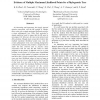Free Online Productivity Tools
i2Speak
i2Symbol
i2OCR
iTex2Img
iWeb2Print
iWeb2Shot
i2Type
iPdf2Split
iPdf2Merge
i2Bopomofo
i2Arabic
i2Style
i2Image
i2PDF
iLatex2Rtf
Sci2ools
BIBE
2006
IEEE
2006
IEEE
Evidence of Multiple Maximum Likelihood Points for a Phylogenetic Tree
An interesting and important, but largely ignored question associated with the ML method is whether there exists only a single maximum likelihood point for a given phylogenetic tree. Mike Steel presented a simple analytical result to argue that the ML point is not unique [11]. However, his view so far attracts only little attention. Though many researchers believe that multiple maximum likelihood points may exist for certain phylogenetic trees, most existing phylogenetic construction programs only produce a single best tree under the ML criterion and in practice many researchers still use only the ML values to make judgment on the quality of different trees for a given problem. In this paper we present some experimental results from a large number of synthetic test data sets and show that it is quite common that certain incorrect trees can have likelihood values at least as large as that of the correct tree. A significant implication of this is that even if we are able to find a truly...
| Added | 10 Jun 2010 |
| Updated | 10 Jun 2010 |
| Type | Conference |
| Year | 2006 |
| Where | BIBE |
| Authors | Bing Bing Zhou, Monther Tarawneh, Pinghao Wang, Daniel Chu, Chen Wang, Albert Y. Zomaya, Richard P. Brent |
Comments (0)

